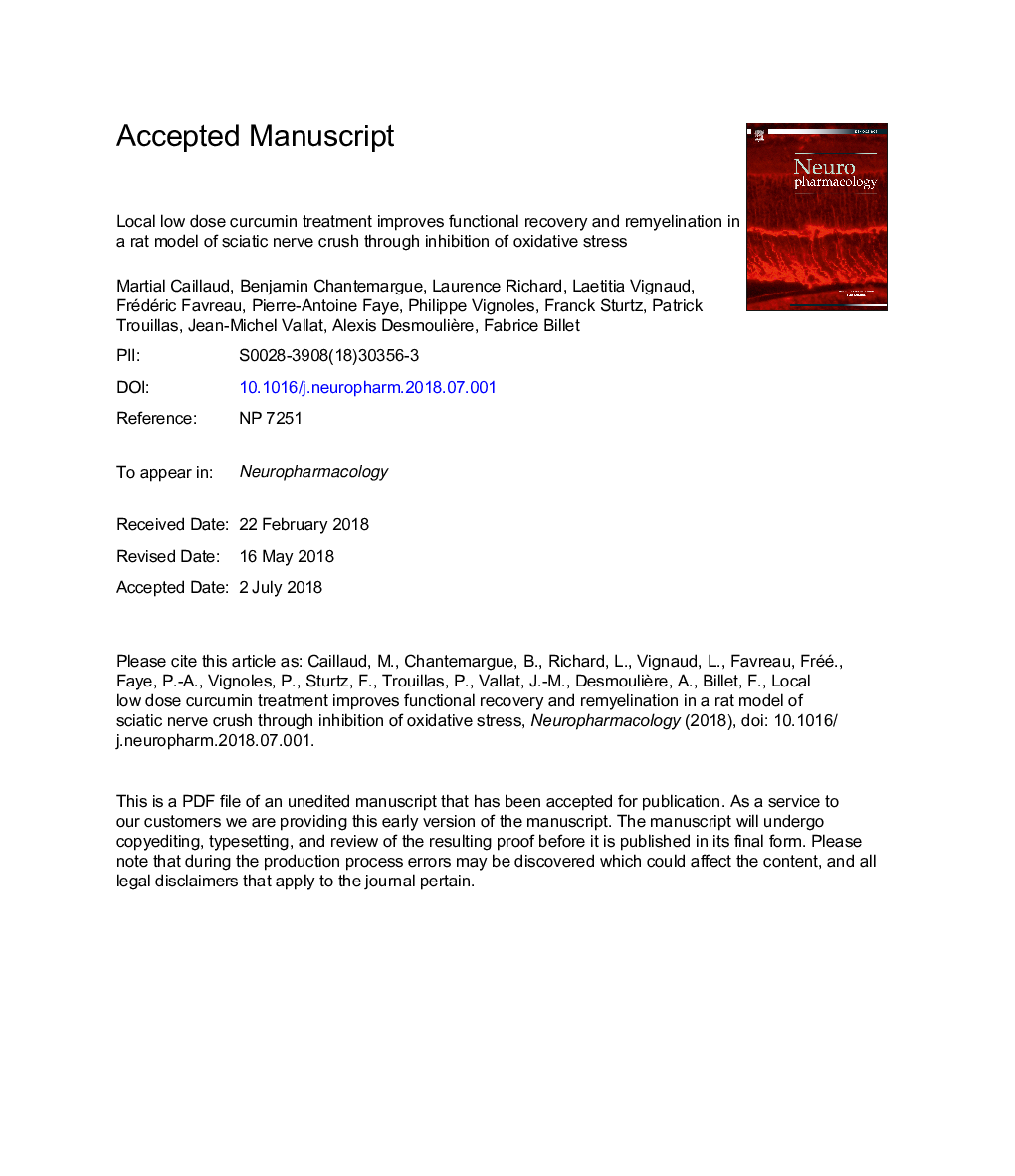| Article ID | Journal | Published Year | Pages | File Type |
|---|---|---|---|---|
| 8516329 | Neuropharmacology | 2018 | 43 Pages |
Abstract
Traumatic injuries to peripheral nerves are frequent, however, specific pharmacological treatments are currently lacking. Curcumin has antioxidant, anti-inflammatory and neuroprotective properties but high oral doses are required for therapeutic use, particularly due to its low bioavailability. The aim of the present study was to investigate the effects of local and continuous treatment using low curcumin doses on functional recovery and nerve regeneration after rat sciatic nerve crush (SNC). Curcumin was administered by osmotic pumps with a catheter delivering the drug at the injury site (0.2â¯mg/day for 4 weeks). Functionally, early improvements in mechanical sensitivity, finger spacing of the injured paw, skilful walking and grip strength were observed in curcumin-treated animals. The curcumin treatment increased expression of compact myelin proteins (MPZ and PMP22), myelin sheath thickness and, correspondingly, increased motor and sensitive nerve conduction velocity. Microscopic analysis of gastrocnemius muscle indicated a curcumin-induced decrease in neurogenic lesions. Curcumin treatment reduced the production of reactive oxygen species (ROS) (which were notably produced by macrophages), lipid peroxidation and increased expression of transcription factor Nrf2. In silico analyses indicated that curcumin combines all the characteristics required to be an efficient lipid peroxidation inhibitor at the heart of biological membranes, hence protecting their degradation due to ROS. This antioxidant capacity is likely to contribute to the beneficial effects of curcumin after SNC injury. These results demonstrate that, when administrated locally, low doses of curcumin represent a promising therapy for peripheral nerve regeneration.
Keywords
HO-1CMAPTSFPoPCNPTNQO1MPZSSITBARSPMP22SNCSCsNrf2MBPAPLGST-PMNCVheme-oxygenase 1Glutathione S-transferase Pp67phoxMDASNCV1-Palmitoyl-2-oleoyl-sn-glycero-3-phosphocholineMPOROSPeripheral NervesHESNADPH oxidaseOxidative stressXanthine dehydrogenase/oxidasemotor nerve conduction velocitySchwann cellSciatic nerve crushantioxidant responsive elementnuclear factor (erythroid-derived 2)-like 2malondialdehydeArea per lipidthiobarbituric acid reactive substancesmyeloperoxidaseMyelinARERespcompound muscle action potentialMyelin protein zeroMyelin basic proteinPeripheral myelin protein 22polyethylene glycolPEGMolecular dynamicBeam walkingCurcuminReactive oxygen species
Related Topics
Life Sciences
Neuroscience
Behavioral Neuroscience
Authors
Martial Caillaud, Benjamin Chantemargue, Laurence Richard, Laetitia Vignaud, Frédéric Favreau, Pierre-Antoine Faye, Philippe Vignoles, Franck Sturtz, Patrick Trouillas, Jean-Michel Vallat, Alexis Desmoulière, Fabrice Billet,
